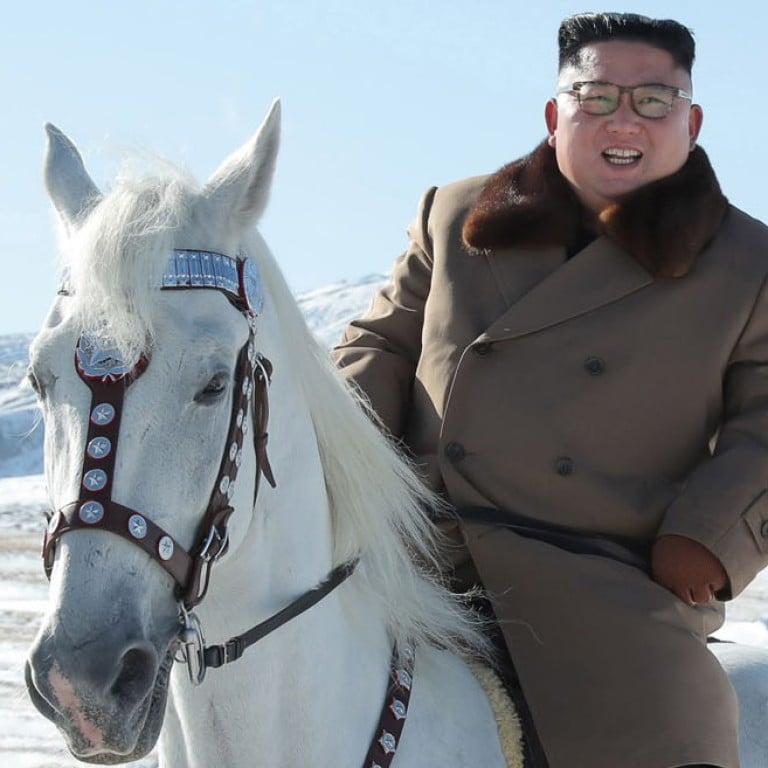
Why is Kim Jong-un riding a horse up a sacred mountain? Some clues from North Korean history
- Internet users mocked photos of Kim’s ride up Mt Paektu, but imagery is full of cultural and political cues, experts say
- Location recalls legacy of leader’s grandfather, Kim Il-sung, while white stallion evokes Korean legends of steeds with superpowers
The internet was flooded with online jokes and memes after North Korea’s state media released the photographs. But for North Koreans steeped in years of tightly controlled messaging from the government, the imagery would have been familiar and full of cultural and political cues.
“The main thing to keep in mind is that while we might think Kim looks goofy, he doesn’t think that,” Jeffrey Lewis, a North Korea expert at the Middlebury Institute of International Studies in California, said on Twitter. “And we won’t always like what he does to make us take him seriously.”
North Korea’s ruling party newspaper Rodong Sinmun devoted its front page on Thursday to making sure Kim’s impoverished people understood the significance of his ride up Mt Paektu, saying it symbolised their leader’s resolve to protect the country in the face of outside pressure.
North Korea is under a number of international economic sanctions, imposed because of its development of nuclear weapons and ballistic missiles, and a record of human rights abuses.
Many ordinary North Koreans are facing food shortages, international aid agencies say, due in part to government failures, poor weather, and the international sanctions.
To reassure North Koreans, Rodong Sinmun said Kim’s ride showed his “unwavering resolve and willpower to defend the dignity and destiny of the nation and the people without vacillating under any threat or temptation”.
Earlier this month, North Korea test fired a submarine-launched ballistic missile and also walked away from denuclearisation talks with US officials in Stockholm.
Kim Jong-un expresses ‘great satisfaction’ over North Korean weapons tests
Kim has said he will wait until the end of the year for the United States to show more flexibility.
“In this acute battle against enemies, the slightest concession or retreat means a path to self-destruction,” the newspaper said in the front-page commentary.
Familiar with Korean mythology, and educated in the state approved history of Kim’s dynasty, North Koreans would have easily recognised the loaded symbolism contained in Kim’s mountain ride.
Mt Paektu, a volcano straddling North Korea’s border with China, is sacred to many Koreans, both in the North and South, who revere it as the mythical birthplace of a unified and independent peninsula.

Kim has often visited the sacred mountain around the time of major developments in North Korea, including missile launches.
According to North Korean history, the leader’s grandfather, Kim Il-sung, based his anti-Japanese military campaign on the mountain. North Korea says Kim Jong-un’s father, Kim Jong-il, was born at Mt Paektu, though historians believe his actual birthplace was in Russia.
“Mt Paektu is the location of Kim Il-sung’s mythical guerilla base,” said Joshua Pollack, another North Korea researcher at Middlebury. “The location and the clothes are meant to evoke the founder’s legacy.”
In another front-page article published by Rodong Sinmun on Thursday, a North Korean man was quoted as saying the images of Kim on horseback wearing a fur-trimmed military greatcoat reminded him of “legendary guerilla fighter” Kim Il-sung.
Kim Jong-un’s secret weapons: his wife, his sister, his subjects
“It was as if the voice of our dear marshal making a solemn declaration of history was echoed loudly,” the article said.
And the handsome white horse Kim rode evoked Korean legends of steeds with superpowers, like the winged horse Chollima, and another named Mallima, that was blessed with great speed and stamina to run for thousands of kilometres.
North Korea named its economic effort to recover from the 1950-53 Korean war after Chollima, and more recently the state has taken to exhorting people to work with the “speed of Mallima”.

Rodong Sinmun called for the nation to move forward at “full speed, like the swift horse of Mt Paektu, toward a new victory”, and quoted Kim calling for progress on economic projects.
“North Korea apparently wants to send the message that US sanctions don’t work,” said Yang Moo-jin, a professor at the University of North Korean studies in Seoul.
“But in the longer term, they aim to achieve balanced economic development.”

